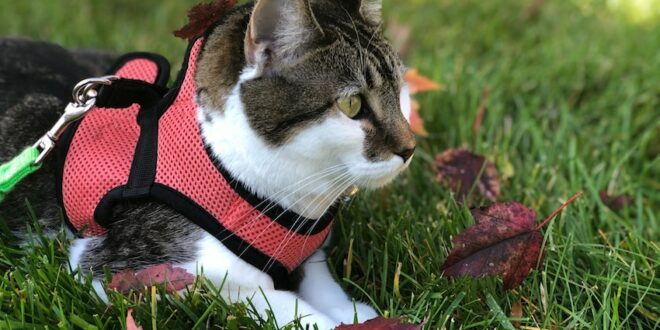With the emphasis on protecting wildlife in urban areas, cat owners are always looking for ways their fur babies can access the big outdoors without causing harm. One solution is to train your cat to walk outdoors on a leash. Although it’s not something that will happen immediately, and it will take a great deal of patience on your part, in some cases it is possible. If you’re considering leash-training your cat, here are some considerations and tips to help get you started.
Is my cat suited to leash walking?
While some cats take to leash walking with ease, others find it stressful. Observe your cat carefully to help you decide how it reacts to being on a leash, and never force it into this activity against its will. Signs your cat is happy on a leash include a relaxed posture, an interest in exploration, usual signs of affection (especially when meeting other people), and taking the lead. Negative signs include back arching, hissing, ears pulled back, resisting walking, trying to return indoors, and attempting to hide.
Choose the correct harness and leash
A cat is not a dog. Don’t attempt to use any dog equipment on your cat (even small-dog equipment is not suitable). When choosing a harness, consult your vet. The harness should be well-fitting and adjustable. Fabric harnesses should be ‘breathable’, and all harnesses are best if they come with reflective binding so if your cat escapes, it will be easily seen at night. Leashes must be lightweight (a light chain is not suitable) and non-retractable (retractable leashes have a mechanism that makes them too heavy for a cat).
Take your time
Training a cat to walk on a leash will take weeks, and possibly months. Don’t rush it. If possible, begin training when your pet is still a kitten. A cat that has regular handling and training in other areas (such as click training to ‘shake hands’ or ‘roll-over’) is likely to be more amenable to harness training, so lavish time on your pet in as many ways as possible.
Familiarisation
Introduce the harness and leash to your pet by leaving it in places where the cat usually likes to spend time. Do this for a week or more before attempting anything else. This will help your pet become used to the sight and smell of the equipment.
Putting on the harness
Always put on the harness in an enclosed space (keep the door to the room shut). This way, if the cat runs off with the harness partially on or unsecured, it is not at risk of getting caught up on an object where it can’t be found. Help your cat associate putting on the harness with treats. Give a treat when the harness is on the cat, never when it is off. Let the cat move about the house (never outdoors) until it becomes used to the harness.
The leash
Once you have attached the leash to the cat’s harness, don’t attempt to take hold of it. But do give treats as rewards. Let your cat have plenty of practice moving about the house with the leash following behind it. Do this over a period of days before you move to the next stage. When your cat is comfortable with the leash, pick up the leash and follow behind the cat without requiring it to follow you. Reward the cat with treats. Once your cat is comfortable with you following with the leash, gently coax it in new directions using treats as lures.
The big outdoors
Some cats will never be comfortable on a leash. Never take a leash-shy cat outdoors. If your cat is ready to go out on a leash, make the first excursions very short (just a few minutes long). Follow the cat rather than directing it, and always offer treats as rewards for good behaviour. After many short excursions, your cat may allow you to lead it.
Training a cat to walk on a leash is no easy task, and it’s not always achievable, no matter how hard you both try. So don’t expect the impossible from your pet, and try not to be disappointed if your training doesn’t succeed. After all, your main job is to love your cat!









Sandie Sharland - 4 years ago
Enjoyed ‘Walkies with your cat’ thanks. After living in Aussie for over 20+ years before moving back home, we shared our lifestyle with a few cats, even brought our last two home. All our Cats were registered with the local council by law and were housed outside in a secure, cost effective enclosure with all weather protection as sun also a concern for animals. Our fur babies adjusted well and we firmly believe lived a life of luxury. Back here in NZ our ‘one and only’ remaining fur baby ‘family’ member of 14yrs, initially shared a purpose built outdoor warm and airy lockup – purchased through Trade Me. She adapted to a leash very easily when we shifted house and is now interested in going outdoors with us staying a safe distance and due to her age she enjoys all her naps indoors and our friends know ‘not to let the cat out’. We are surrounded by many bird species and wildlife who remain untouched and non-threatened through out attempts to treat our cat well whilst respecting nature. Appropriate outdoor housing and care is not inhibiting or unkind to your cat – its being responsible.